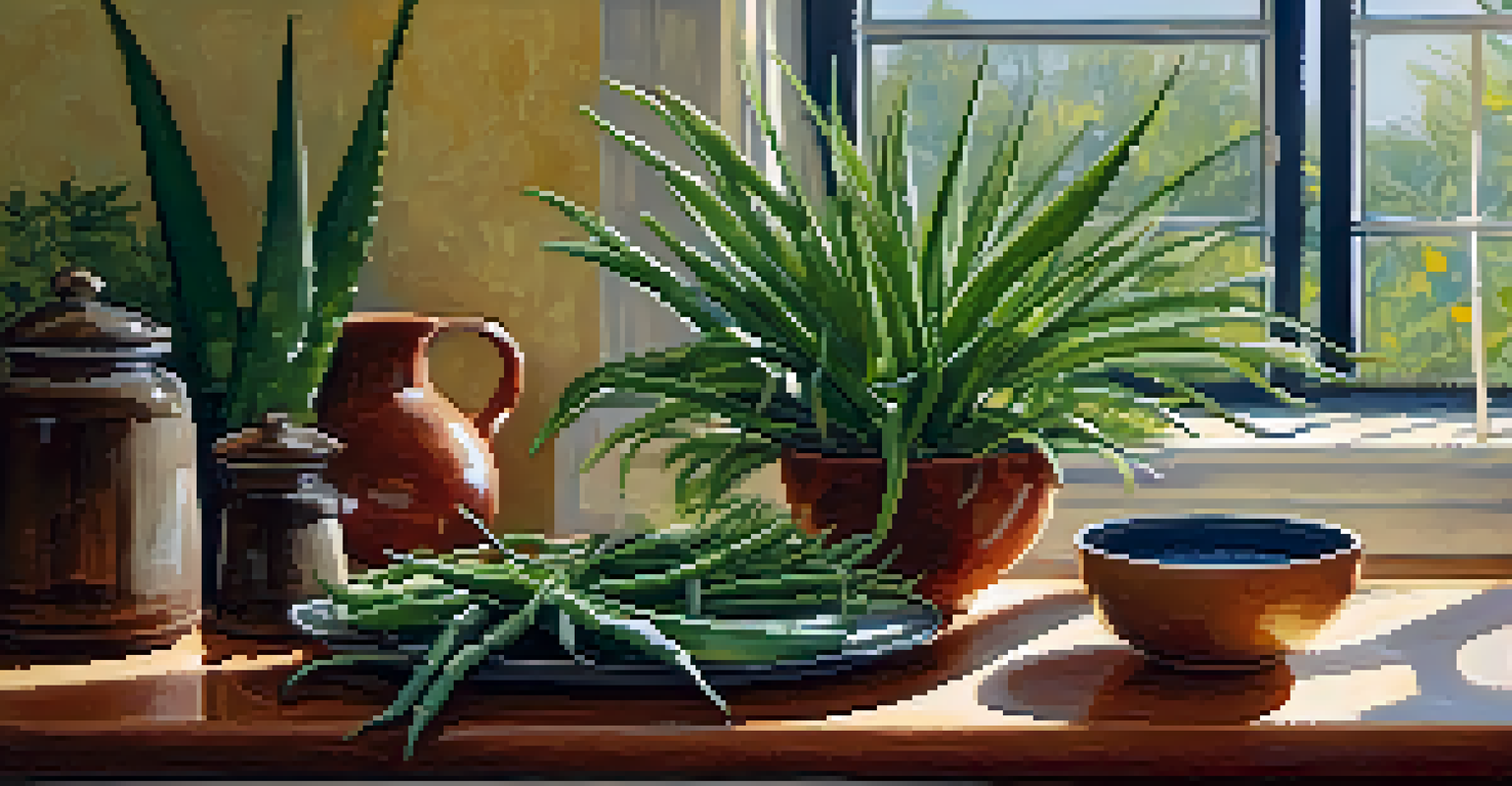Brazil's Medicinal Plants: A Guide to Healing Herbs

Introduction to Brazil's Rich Herbal Heritage
Brazil is a treasure trove of biodiversity, home to thousands of plant species, many of which have medicinal properties. Indigenous cultures have long utilized these plants for healing, creating a rich tapestry of herbal knowledge that spans generations. Understanding this heritage not only connects us to nature but also opens doors to natural remedies that can complement modern medicine.
The greatest medicine of all is to teach people how not to need it.
Many of these plants are not just local wonders; they are gaining recognition worldwide for their health benefits. From the Amazon rainforest to the Atlantic Forest, Brazil's unique ecosystems host herbs that have been used for everything from pain relief to digestive aid. This guide will explore some of the most significant medicinal plants, offering insights into their uses and benefits.
As we delve deeper into this vibrant world of healing herbs, we will uncover how these plants can be integrated into our daily lives. Whether you're looking for natural remedies or simply curious about herbal medicine, Brazil's medicinal plants offer a wealth of knowledge and potential health benefits.
The Amazon Rainforest: A Source of Healing
The Amazon rainforest is often referred to as the 'lungs of the Earth,' but it's also a vital source of medicinal plants. Many indigenous communities rely on this lush environment for their health and well-being, using a variety of herbs to treat ailments. For example, the Guaraná plant is known for its stimulating properties, often used to boost energy and enhance mental clarity.

Another significant plant from this region is the Ayahuasca, famous for its psychoactive properties that are used in traditional ceremonies. While it’s often associated with spiritual healing, many also claim it offers profound psychological benefits. This complex brew highlights how some plants can serve multiple purposes, from spiritual enlightenment to therapeutic applications.
Brazil's Herbal Heritage Explored
Brazil's diverse ecosystems host numerous medicinal plants that have been used for healing by indigenous cultures for generations.
The biodiversity in the Amazon means that many plants have yet to be studied extensively, leaving a wealth of potential remedies untapped. As researchers continue to investigate these natural wonders, we may discover even more ways these plants can support our health and well-being.
Popular Medicinal Plants in Brazil and Their Benefits
Some of the most popular medicinal plants in Brazil include Aloe Vera, known for its soothing properties for skin irritations. This versatile succulent can be applied topically for burns or ingested to aid digestion. Its popularity is a testament to how effective and accessible natural remedies can be.
Nature itself is the best physician.
Another well-known herb is Jambolão, or Brazilian Plum, which is celebrated for its potential to regulate blood sugar levels. This fruit and its leaves are often used in teas and tinctures, offering a delicious way to support metabolic health. Such examples illustrate how integrating these herbs into our diets can be both beneficial and enjoyable.
Lastly, we have the powerful Mulungu tree, traditionally used as a calming agent. Its bark and flowers are brewed into teas that help reduce anxiety and promote relaxation. These examples showcase the range of medicinal plants available in Brazil, each with unique properties that can contribute to our overall wellness.
How to Use Brazilian Medicinal Plants Safely
While Brazilian medicinal plants offer many health benefits, it's essential to use them safely and responsibly. Before incorporating any new herb into your routine, it's wise to consult with a healthcare professional, especially if you are pregnant, nursing, or taking medications. They can help you understand potential interactions and ensure you're choosing the right remedies for your needs.
Start with small doses to see how your body reacts, and keep a journal to track any changes or effects you notice. Remember, just because something is natural doesn't mean it's free from side effects. Being mindful and informed will help you enjoy the benefits of these plants without unintended consequences.
Safety in Using Medicinal Plants
Consulting with healthcare professionals and starting with small doses are essential for safely incorporating Brazilian medicinal plants into your routine.
Additionally, sourcing your herbs from reputable suppliers is crucial. Wildcrafting — or foraging for plants — can be a rewarding experience, but ensure you have proper identification knowledge and respect for the environment. Sustainable practices help preserve these valuable resources for future generations.
The Role of Traditional Medicine in Modern Health
Traditional medicine has played a vital role in Brazil's healthcare system for centuries. The knowledge passed down through generations continues to influence how people view and use medicinal plants today. Many Brazilians still turn to herbal remedies for various ailments, blending traditional practices with modern treatments.
The growing interest in natural remedies has sparked a resurgence in the use of herbal medicine, with many individuals seeking alternatives to pharmaceutical options. This shift reflects a broader trend towards holistic health, where the mind, body, and spirit are considered in treatment plans. Understanding the cultural significance of these practices can enrich our appreciation for their benefits.
As science continues to investigate the efficacy of these plants, we may see greater integration of traditional medicine into mainstream healthcare. This collaboration could lead to innovative treatments that honor both ancient wisdom and modern research, ultimately providing more comprehensive health solutions.
Exploring Herbal Teas Made from Brazilian Plants
Herbal teas are one of the most approachable ways to experience the benefits of Brazilian medicinal plants. From the soothing properties of Chamomile to the invigorating effects of Guaraná, these brews can cater to a variety of needs. Each tea offers a unique flavor profile and health benefits, making them a delightful addition to your daily routine.
For example, a tea made from the leaves of the Jambolão plant can help regulate blood sugar while offering a sweet, fruity taste. Similarly, a blend of Mulungu and Chamomile can create a calming infusion perfect for winding down after a long day. These combinations not only promote wellness but also provide an opportunity to savor the rich flavors of Brazil’s natural offerings.
Herbal Teas for Wellness
Herbal teas made from Brazilian plants offer a flavorful way to experience their health benefits while connecting with nature.
Making herbal teas at home is simple and rewarding. You can experiment with different plants and blends to discover what works best for you, turning your kitchen into a mini apothecary. This hands-on approach allows you to connect with the plants on a deeper level, enhancing your appreciation for their healing properties.
Conclusion: Embracing Brazil's Herbal Wisdom
Brazil's medicinal plants represent a rich heritage of herbal wisdom that deserves our attention and respect. By understanding their uses and benefits, we can harness the power of nature to improve our health and well-being. This journey into the world of healing herbs is not just about finding remedies, but also about connecting with a culture that values the relationship between people and plants.
As we embrace this knowledge, we must also prioritize sustainable practices to protect these valuable resources. Supporting local growers and ethical sourcing of herbs ensures that we can continue to benefit from these plants for generations to come. It’s a small step that can make a significant impact on the environment and communities.

Incorporating Brazilian medicinal plants into our lives is a beautiful way to honor this rich tradition while enhancing our wellness. So, whether you're sipping a herbal tea or exploring new remedies, remember that each plant carries with it a story worth sharing.